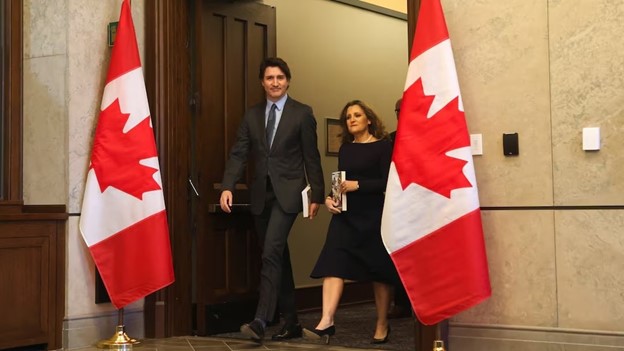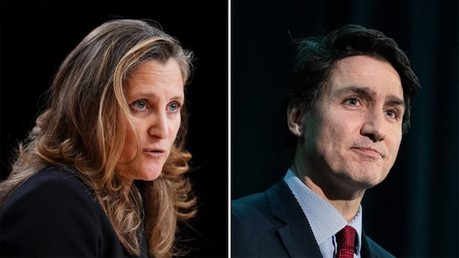Canadian Prime Minister Justin Trudeau’s political future is increasingly uncertain after the unexpected resignation of Chrystia Freeland, his former deputy prime minister and finance minister.
According to the reports received by Leaders team, Freeland’s departure on Monday was accompanied by an open letter in which she outlined policy disagreements with Trudeau, particularly on government spending and what she described as “the best path forward for Canada.” Her concerns were heightened by the looming threat of tariffs on Canadian goods from incoming U.S. President Donald Trump—tariffs that could potentially deal a severe economic blow to Canada.
Freeland’s exit has ignited debates on Parliament Hill and within Trudeau’s own Liberal Party, raising questions about his ability to lead during this pivotal moment.
Trudeau’s Options
- Resign from Leadership
Trudeau has been the Liberal Party leader since 2013 and Canada’s prime minister for nine years. Under the Liberal Party’s constitution, he could resign at any time. Doing so would either prompt the appointment of an interim leader or allow him to remain in his post until a new leader is elected.
Once a successor is in place, Trudeau would hand over his powers as prime minister.
- Hold On and Face the Pressure
As per the sources of Leaders team, despite mounting challenges, Trudeau has shown no signs of stepping down. Following Freeland’s resignation, Trudeau held an emergency caucus meeting and reportedly told Liberal MPs, some of whom had called for his resignation, that he would take time to reflect on the situation.
In a recent holiday address to Liberal supporters, Trudeau acknowledged the difficulties of political leadership, stating, “In difficult times, it’s not time to stop. It’s time to be ambitious, audacious.”
Trudeau’s approval ratings have been in steady decline since the summer, compounded by significant losses in by-elections for traditionally safe Liberal seats. In October, 24 Liberal MPs signed a letter urging him to step aside.
Still, Trudeau has vowed to run for re-election as party leader, and only a small fraction of Liberal MPs have openly called for his resignation. However, under party rules, his leadership can only be formally contested following an election defeat.

- Face a No-Confidence Vote
The opposition Conservative Party, buoyed by strong poll numbers, has repeatedly tried to trigger a federal election through no-confidence votes in the House of Commons.
If the government loses a confidence motion, it must either resign or dissolve parliament, leading to an election. However, the Conservatives have so far been unable to secure enough votes, as the NDP or Bloc Québécois have often sided with the Liberals in exchange for advancing their own political agendas.
On Monday, NDP leader Jagmeet Singh called for Trudeau’s resignation, indicating a potential shift. Singh’s party has also signaled its willingness to support a no-confidence motion if Trudeau remains in power in the new year.
- Prorogue Parliament to Delay the Crisis
Trudeau could choose to prorogue parliament—a suspension of proceedings that would temporarily prevent debates or votes, including a confidence motion.
Although a legitimate parliamentary procedure, prorogation is sometimes used as a political tool to navigate crises. Trudeau last employed it in August 2020 amid an ethics scandal, while former Prime Minister Stephen Harper used it in 2008 to avoid a no-confidence vote.
Parliament is now adjourned for the holidays, and no-confidence motions will not be on the table until at least late January.
What Lies Ahead
Regardless of the path Trudeau chooses, an election in the coming months appears inevitable. Canada must hold its next federal election by October, leaving the ultimate decision on Trudeau’s leadership to voters.









